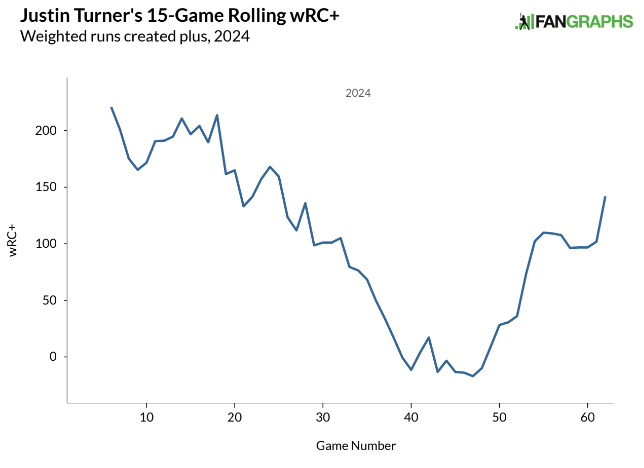Nearing the midway mark of the 162-game schedule, the Toronto Blue Jays still have more than a few struggling veteran hitters on their roster as the 2024 season continues to slip away, and they’ve waited long enough for better results to arrive — only to be disappointed.
The time for waiting is over. Now, it’s time to take action.
Toronto has slowly started coming around in that regard as of late, cutting bait with a pair of faltering vets in Cavan Biggio — traded to the Los Angeles Dodgers last week — and Daniel Vogelbach to make room for the arrivals of Spencer Horwitz and Addison Barger.
But playing time — or a lack thereof — was the primary reason it took as long as it did for those two to get here. While Biggio and Vogelbach’s departures are a start, their subtractions alone likely won’t be enough to create sufficient opportunities for Horwitz and Barger. At least, not unless the Blue Jays apply drastic measures involving George Springer, Justin Turner and Kevin Kiermaier.
Those three are vital to this equation. For Barger to receive regular at-bats, reps must become available at third base, DH or in the outfield corners. Similarly, Horwitz can only become a consistent participant if playing time opens up at first, second or DH.
To this point, the Blue Jays have dragged their feet while debating whether to sit Springer or Turner for an extended stretch, holding out for a surge in production. Though they’ve pulled back on Kiermaier’s opportunities lately, as he’s entered as a defensive replacement in five of his 13 games this month, he’s still probably earning too many at-bats for someone with a 56 wRC+ in 2024.
Arriving at these conclusions is never simple, especially since it involves three well-respected veterans. However, this team has to try to save its season in whatever way possible, even if that comes at the expense of three clubhouse leaders.
So, the Blue Jays must soon choose a direction: stay the course and hold out for improved production from their struggling veterans (which may never come) or shift the playing time scale to the nine hitters who give you the best chance of winning each game.
Everything else aside, this organization’s decision should ultimately lie in the results.
Let’s start with the recent triple-A call-ups. Horwitz was raking in Buffalo, thriving to a .335/.456/.514 with 28 extra-base hits (four home runs) and an eye-bursting 158 wRC+ across 57 games. He hit for more power without sacrificing his exceptional plate discipline, still earning more walks (44) than strikeouts (41) for a second consecutive year with the Bisons.
Not even a new position has slowed him down, as shifting to second base hasn’t affected the 26-year-old’s offensive production since returning to the majors, considering he’s 9-for-27 (.333) and has driven in a trio of runs in eight games with the Blue Jays thus far. With four walks, he’s reached safely in close to 50 per cent of his at-bats in this tiny sample size, maintaining his reputation as an on-base machine.
Horwitz hits IKF home and the Jays take a 2-0 lead! 🙌
📺: Sportsnet
📲: Stream on Sportsnet+ pic.twitter.com/6AXrlr7YI8— Sportsnet (@Sportsnet) June 12, 2024
Barger, meanwhile, already has three hits and a walk in two games (eight plate appearances) since his promotion. That’s much improved from the lone hit and six punchouts logged during his brief big-league stint earlier this season. He’s also squared up two pitches with exit velocities of at least 100 m.p.h., showcasing his most appealing attribute that was absent in his first go-around.
Despite these impressive showings, the Blue Jays had Horwitz and Barger on the bench in Monday’s series opener against the Boston Red Sox, a puzzling decision with B.C. native Nick Pivetta, a right-handed starter, on the mound. Instead, Turner, the offence’s leading star with his double and solo shot, drew the start while the outfield trio of Daulton Varsho, Springer and Kiermaier went a combined 1-for-11.
Granted, it’s difficult to win when your starter allows four home runs — all solo blasts — in just four innings of work, especially in front of a struggling offence. At the same time, this team opened at a disadvantage with two sources of positivity fresh from the minors sitting on the bench.
The Blue Jays can no longer afford to wait for better days with the likes of Springer, whose struggles at the plate trace back to last season. We aren’t dealing with a small sample size here. It’s much more than that. Since the start of 2023, the declining four-time All-Star ranks 99th out of 121 qualified major-league hitters in wRC+ at 95. This season, he sits 146th out of 151 in that category with a 72 wRC+.
At 34, Springer’s swing decisions are one of the few upsides his offensive profile has left, considering his walk, strikeout and chase rates are each in the 80th percentile or higher. But almost every other advanced metric, including his hard-hit rate, barrel rate, average exit velocity and expected statistics, is positioned well below league average.
Shifting away from Springer as a full-time player is long overdue. And yet, despite his rapid decline, he’s logged the third-most plate appearances (273) on the team this season, trailing only Bo Bichette (276) and Vladimir Guerrero Jr. (314). It’s time for that playing time to go to someone else.
With Barger — whose arm strength arguably leads the organization — a capable defender in right field, he should start as often as possible versus right-handed pitching. As should Horwitz, too, whether on the right side of the infield or as the DH.
First base, of course, belongs to Guerrero. So, reps won’t be easy to come by there. And starting Horwitz at second consecutively means one of Davis Schneider, Ernie Clement, or Isiah Kiner-Falefa would start on the bench — a less-than-ideal scenario given that trio’s recent success. That brings us back to Turner, who, despite recovering from his month-plus hitting slump, is likely better suited for a platoon DH role.

Turner’s downturn in May, plus Vogelbach’s uptick in production, resulted in a sharing arrangement at DH between that duo largely determined by matchup splits. And it proved quite effective, at least to some degree, possibly creating a template for Horwitz’s deployment at that position.
Further reducing Kiermaier’s at-bats should also help create additional opportunities to insert the Buffalo Boys into Toronto’s lineup more frequently, allowing Varsho to operate in centre regularly, ensuring at least three of Horwitz, Schneider, Clement and Kiner-Falefa are among the starting nine.
All this could change dramatically depending on performance, and rightly so. But considering the July 30 trade deadline arrives next month, the debate over who’s starting and who isn’t will become irrelevant if the Blue Jays don’t start scoring more runs to improve their chances of surviving a gruelling June schedule.
The likes of Schneider, Horwitz, Barger and perhaps other triple-A graduates will be playing regularly the rest of the way if this club drops out of the playoff race before August anyway. So, why not hand them the reins now to see if they can help avoid such a disastrous fate?


